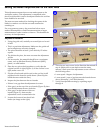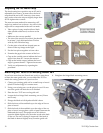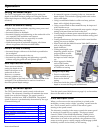
Trimming the Outrigger Splinter Guard
The outrigger splinter guard is used to prevent chipping on
the offcut side of the sawblade. The outrigger can be
retracted away from the workpiece when not needed.
Before the outrigger splinter guard is used for the first
time, it needs to be trimmed to fit the sawblade.
1. Remove the thumbscrew from the outrigger and
slide the outrigger on to the front edge of the blade
guard as shown.
2. Insert the thumbscrew through the outrigger,
through the height adjustment slot, and into the
captive nut on the back side of the outrigger.
3. Raise the outrigger to its top position and tighten
the thumbscrew.
4. Place the saw on a stable surface so that the blade
can be plunged down without cutting the surface
(or use a piece of scrap wood).
5. Set the motor speed to its lowest setting (setting 1).
6. Start the saw and slowly plunge the blade to full
depth.
Replacing and Adjusting the Riving Knife
Periodically inspect the riving knife to ensure it is not bent and
has proper clearance away from the blade. Replace if bent.
1. Unplug the saw for safety.
2. Raise the FastFix latch lever and plunge the saw until it locks
into position (see page 10 for more information on the
FastFix lever).
3. Using the arbor wrench (stored in the auxiliary handle)
loosen the riving knife mounting screw.
4. If the riving knife needs replacement, slide it out of its
mounting, and slide a new knife back in.
5. Raise or lower the riving knife so there is a 2 to 4 mm (3/32
to 5/32 inch) clearance between the knife and the blade.
6. Retighten the mounting screw.
Instruction Manual 9


















